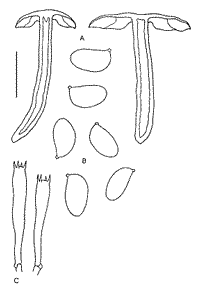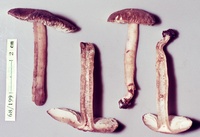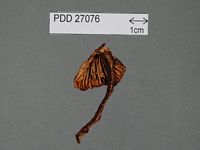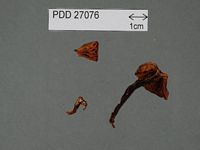|
 Neohygrocybe innata Neohygrocybe innata
SynonymsHygrocybe innata
BiostatusPresent in region - Indigenous. Endemic
Images (click to enlarge)
Caption: Fig. 8: Neohygrocybe innata Hk. (type): k. carpophores. - 1. spores. - m. basidia. - n. cuticle | 
Caption: Fig. 49 Neohygrocybe innata Horak (A-C: PDD 27076, type): A.
basidiomes. U. spores. C. basidia. | 
Caption: ZT68-199, Holotype
Owner: E. Horak: © Creative Commons Attribution-Noncommercial 3.0 New Zealand | 
Caption: Dried type specimen
Owner: Herb PDD | 
Caption: Dried type specimen
Owner: Herb PDD |
Article: Horak, E. (1990). Monograph of the New Zealand Hygrophoraceae (Agaricales). New Zealand Journal of Botany 28(3): 255-306 (http://www.rsnz.org/publish/abstracts.php).
Description: Pileus -45 mm, hemispherical or convex becoming plano-convex or expanded; pale
brown, densely covered with concolorous, radially arranged, squamulose fibrils
and scales (like Inocybe sp.); dry, slightly hygrophanous, margin non-striate.
-Lamellae moderately distant, emarginate-adnexed; whitish, turning pinkish to
brownish after bruising, edges entire, obtuse, concolorous. - Stipe 30-60 x
5-8 mm, cylindrical, equal or attenuated towards base, often curved; whitish
to concolorous with pileus; dry, densely covered with innate, longitudinal fibrils,
hollow, fragile, single. - Context whitish, turning pink or red on exposure
or after bruising. - Odour alkaline. - Taste mild. - Chemical reactions on pileus:
KOH - pale brown; HCI - negative.
Spores 7-8.5 x 4.5-5 um, ovoid to ellipsoid. - Basidia 32-40 x 6 um, 4-spored.
- Cystidia absent. - Pileipellis a cutis or trichoderm of cylindrical hyphae
(4-10 um diam.), membranes not gelatinised, with plasmatic pigment; clamp connections
rare on cuticular hyphae (Pl. 1, Fig. 2).
Habitat: ECOLOGY: Rare; saprobic on soil among litter in broadleaved-conifer forests.
March.
Distribution: DISTRIBUTION: NZ (WL).
Notes: In several characters this species resembles the European Hygrocybe nitiosa
(Blytt) Moser (= H. ingrata Jcns. & Moeller) but the spores of the
New Zealand taxon are smaller and its slightly reddening context docs not blacken
on exposure and/or with age.
Article: Horak, E. (1973). Fungi Agaricini Novazelandiae I-V. Beihefte zur Nova Hedwigia 43: 200 p.
Description: Pileus 20-45 mm diam., hemispherical or convex when young then plano-convex or expanded, light brown, covered with radially arranged, innate, concolorous fibrils (like Inocybe), dry, slightly hygrophanous, estriate. Lamellae emarginate-adnexed, whitish, pinkish to brownish when bruised, distant, thick, gill edge even, concolorous. Stipe 30-60 x 5-8 mm, cylindric, equal or attenuated towards the base, often curved, whitish to concolorous with pileus, densely covered with innate, longitudinal fibrils, dry, hollow, fragile. Context whitish, turning pink or red. Odor alkaline to fruity. Taste mild. Chemical reactions on Pileus: KOH - brownish; HCl - negative.
Spores 7-8.5 x 4.5-5 µm, ovoid to ellipsoid, smooth, inamyloid. Basidia 32-40 x 7 µm, 4-spored. Cheilo- and pleurocystidia absent. Cuticle a cutis consisting of cylindric. repent hyphae (4-10 µm diam.), membranes not gelatinized. plasmatic pigment present. Clamp connections rare on the cuticular hyphae.
Habitat: Amongst litter of Dacrydium cupressinum, Metrosideros umbellata, Quintinia, etc. New Zealand.
Notes: This species resembles in some ways H. nitiosus (Blytt) but its spores are smaller and its context is less reddened and not blackening at all (Haller 1951: 179).
|